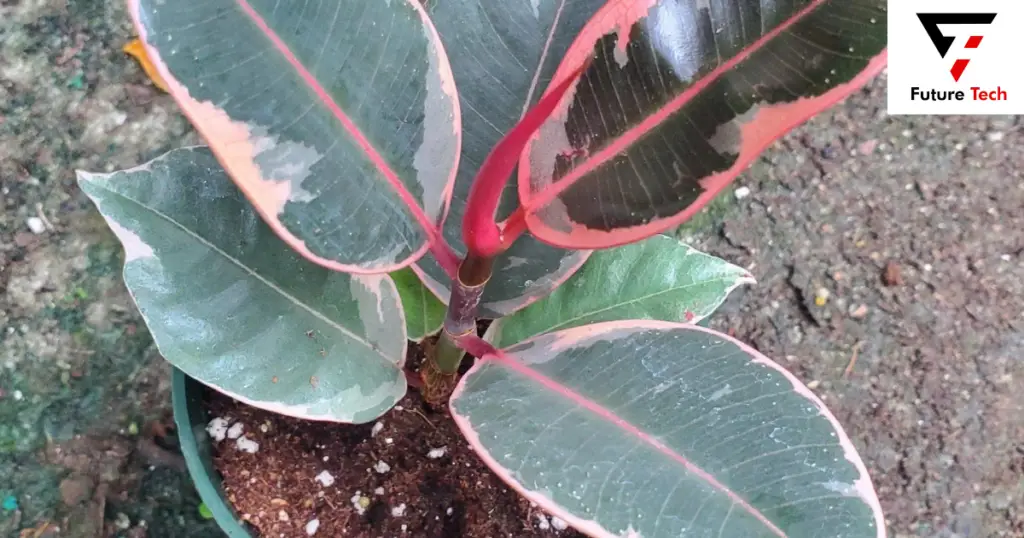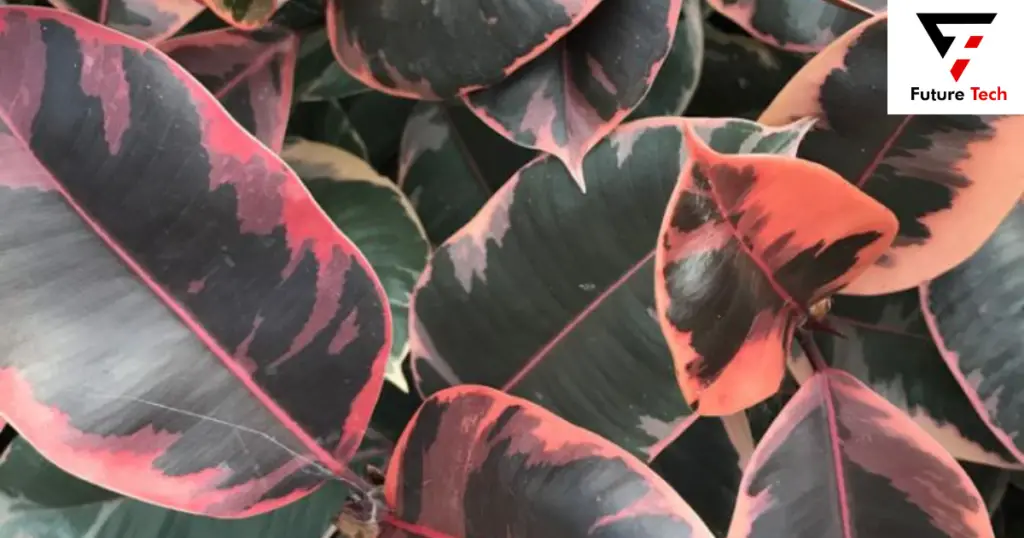This ficus jewel requires a little cleaning to keep it shining and clean! The glossy leaves of Ficus Ruby have a subtle pink and brilliant crimson hue. Try planting this Rubber Tree ‘Ruby’ in bright indirect light to see it burst with color; however, keep it out of direct sunlight to prevent leaf burn. Hurt! Remember that each ruby is unique, and a plant’s coloration is a light exposure function! Watering Ficus elastica “Ruby” regularly will result in the leaves dropping. Thus, letting the soil dry out in between applications is best. Once you have chosen an area where it thrives, this easy-to-maintain indoor plant likes to stay put! Find out more about the care that Ficus Ruby needs!
Phylum: Araceae
Common Name: Rubber Tree’ Ruby’
Botanical Name: Ficus elastica ‘Ruby
Ficus Elastica Ruby History:
It is a lovely, varied cultivar of rubber trees native to India and Malaysia. It displays a broad spectrum of hues. The intensity of each plant’s color will differ.
Identification of Ficus Elastica Ruby
The glossy, ovate-shaped leaves of Ficus Elastica Ruby come in pink, red, and cream hues. The growth habit of this plant is vertical.
Facts About Ficus Elastica Ruby Growth
This fast-growing plant will tilt toward the light, so turn it occasionally to promote even growth. Regular pruning will be necessary to keep the size of this plant under control.
How Much Size Can a Ficus Elastica Ruby Acquire?
This plant can grow to less than 10 feet when planted indoors, but it can reach up to 100 feet in its natural habitat.
What Makes Ficus Elastica Ruby Special?
Ficus elastica Ruby plants are usually native to the tropical regions of Malaysia and India, where they grow for their rubber trees. This tropical beauty can reach 30 feet or more when grown outside, but your potted plant should reach approximately ceiling height indoors. The flexible focus Because of its gorgeous variegated leaves with pink and red streaks against a dark green background, Ruby grows well-liked. These plants in your home will also help you purify the air by removing formaldehyde, germs, and mold spores.
Care for Ficus elastica Ruby
It is native to South Asia’s tropical rainforests and grows beneath tree canopy cover. The ideal way to take care of a Ficus ruby is to keep it out of the direct sun and provide a warm, humid environment. Once those prerequisites are satisfied, caring for a Ficus elastica Ruby plant is quite simple.
Light

The trees that Ficus elastica Ruby thrives beneath provide shade from the intense equatorial sun in its natural rainforests. It needs between 15,000 and 20,000 lux, or bright, indirect light. Although they cannot withstand direct sunlight, they have enough light to preserve their main feature—the vibrant variegation on their leaves. If you place your Ficus Ruby near a north or east window, where the morning sun will be moderate, you may easily meet its light needs. However, it would be best if you kept it out of the scorching afternoon sun and away from windows in rooms that face south or west.
Watering
Watering Ficus elastica ruby aims to keep the soil at a constant moisture content without letting it get too wet. Water Ficus Ruby as soon as the top few inches of soil dry out before the container dries. Water the soil gently, emptying the saucer of any water that builds up. It is not going to sit in the water. Because tap water contains pollutants that can harm Ficus elastica Ruby, it is better to use rainwater or distilled water for the plant’s irrigation needs. If you must use tap water, leave it alone for the entire night to allow the chlorine and fluoride to evaporate.
Temperature
It becomes accustomed to warm weather all year round in its natural habitat close to the equator. The recommended temperature range for Ficus elastica ruby is 70–77°F (21–25°C). For Ficus ruby, most households may quickly provide a suitable temperature. Below 60ºF (15ºC), It can only withstand a certain amount of heat. Please keep it away from air conditioning vents and drafts. Since it lacks frost tolerance, bring your Ficus Elastica Ruby inside well before the bitter cold sets in your area if you leave it outside throughout the sweltering summer months. The plant will suffer from lows of 60ºF (15ºC) even overnight.
Temperature of Humidity
Although the tropical rainforest is a humid habitat, it doesn’t need much humidity. Although 40–60% humidity is best for Ficus ruby, it can survive lower humidity levels. You will have to assist the leaves if the edges are becoming a little brown. The least expensive solution is to set your Ficus Elastica Ruby’s pot beneath a pebble tray filled with water. Directly around the leaves, evaporation will moisten the air. Investing in a modest humidifier can also help maintain the health of your tropical plants. It is not good to mist the leaves of Ficus elastica Ruby.
Soil
Ficus elastica Ruby soil should be well-drained, porous, and nutrient-rich. It should also be able to hold onto moisture. Ficus ruby prefers a pH of 5-7, somewhat acidic to neutral. Use standard cactus soil for Ficus ruby if you can readily locate it. To increase the soil mix’s nutrient content, add additional compost. You may adjust regular potting soil to create the ideal Ficus elastica Ruby soil mix. If you want nutrient-rich, well-draining soil that stays consistently moist, mix one part fertilizer, one part perlite, and a generous scoop of compost.
Additives
Ficus ruby needs fertilizer to ensure strong, healthy development. For Ficus elastica ruby, a balanced 10-10-10 fertilizer mix is ideal. Standard liquid fertilizer for home plants is the best option for Ficus elastica ruby, but dilute it to half the recommended strength to prevent scorching the roots. When the plant is not actively developing, in the fall and winter, you should not water your plant; instead, water it once a month during the spring and summer. For optimal absorption, apply the liquid fertilizer straight to the soil’s surface soon after watering. Avoid getting it on the foliage.

Common Ficus Elastica Ruby Challenges
It is giving Ficus Elastica Ruby the growth conditions it requires to flourish. Still, illnesses and pests can pose difficulties for Ficus ruby, so maintaining its health will require treatment. To identify such issues early on, carefully watch its leaves.
Pests
Mealybugs and scale are the most likely pests to affect Ficus elastica ruby. Take immediate action to eliminate any problems causing significant harm to your Ficus ruby, and take precautions in the future. Mealybugs often gather on the undersides of leaves, resembling small patches of puffy cotton. Using a cloth drenched in rubbing alcohol and an insecticidal soap spray makes it simple to eliminate them. Usually seen on stems, but sometimes on foliage, scale insects resemble little brown lumps. The best technique to handle them is to scrape them off because they are more difficult to remove. Next, apply insecticidal soap or neem oil all over the plant.
Illnesses
Overwatering is the main cause of illnesses in Ficus elastica ruby. You might have root rot if the foliage on your Ficus ruby is turning yellow and the stems appear soft. Examine the roots after taking the plant out of the pot. Remove any impacted roots, leaves, and stems if they become black, then report them in new soil. Proceed to reduce the amount of irrigation. Algal leaf spots appear on the leaves as gray, green, or orange patches that eventually turn brown. After you’ve removed the afflicted foliage, keep the remaining leaves dry at all times, as this results from excessive humidity surrounding the leaves.
Increasing Issues
Unsuitable growing environments lead to additional growing issues. Give your sick plant a more favorable atmosphere for healthy growth to help it recover.
Conclusion
The Elastic Ficus The glossy, ovate-shaped leaves of the tropical rubber tree Ruby, native to Malaysia and India, come in shades of pink, red, and cream. It can grow up to 100 feet in its native habitat, but indoor cultivation limits it to less than 10 feet. Placing the plant near a north or east window will allow it to receive morning sun, and it needs between 15,000 and 20,000 lux of light. It’s important to water, but you should do it gently and in a warm, humid place. Temperature and light levels affect the plant’s growth in tropical rainforests.
Ficus elastica Ruby prefers temperatures between 70 and 77°F (21 and 25°C), and it grows best in warm climates close to the equator. It can tolerate lower humidity levels but doesn’t require much of it. The right soil—pH 5-7—and fertilizer are necessary for good growth. Scale and mealybugs are prevalent pests that need careful treatment. Illnesses can result from root rot, overwatering, and algal leaf spots. A good growth environment can aid in the plant’s recovery from further problems. The early identification and resolution of these issues are critical to the plant’s growth and well-being.
